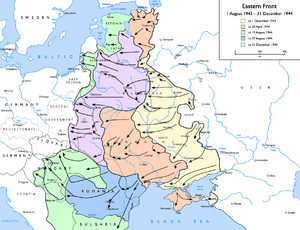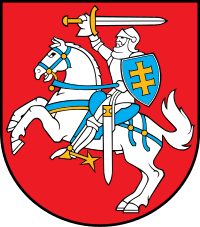Resistance in Lithuania during World War II


During World War II, Lithuania was occupied by the Soviet Union (1940–1941), Nazi Germany (1941–1944), and the Soviet Union again in 1944. Resistance during this period took many forms. Significant parts of the resistance were formed by Polish and Soviet forces, some of which fought with Lithuanian collaborators. This article presents a summary of the organizations, persons and actions involved.
First Soviet occupation
In 1940, President Antanas Smetona fled to Germany, not wanting his government to become a puppet of the Soviet occupation. Soviet attempts to capture him were unsuccessful, and he was able to settle in the United States.
In 1940, Chiune Sugihara, the Japanese consul in Kaunas, and his wife Yukiko disobeyed orders and saved thousands of Jewish refugees from Poland by granting them visas.[1]
In 1941, the Lithuanian Activist Front (Lithuanian: Lietuvos Aktyvistų Frontas) formed an underground government, and following the June uprising, the Provisional Government of Lithuania maintained sovereignty for a brief period.
Nazi German occupation
Soviet partisans began sabotage and guerrilla operations against German forces immediately after the Nazi invasion of 1941. The activities of Soviet partisans in Lithuania were partly coordinated by the Command of the Lithuanian Partisan Movement headed by Antanas Sniečkus and partly by the Central Command of the Partisan Movement of the USSR.[2]
In 1943, the Nazis attempted to raise a Waffen-SS division from the local population as they had in many other countries, but due to widespread coordination between resistance groups, the mobilization was boycotted. The Lithuanian Territorial Defense Force (Lietuvos vietinė rinktinė) was eventually formed in 1944 under Lithuanian command, but was liquidated by the Nazis only a few months later for refusing to subordinate to their command.[3][4][5]
There was no significant violent resistance directed against the Nazis. Some Lithuanians, encouraged by Germany's vague promises of autonomy,[6] cooperated with the Nazis. Pre-war tensions over the Vilnius Region resulted in a low-level civil war between Poles and Lithuanians.[7] Nazi-sponsored Lithuanian units, primarily the Lithuanian Secret Police,[7] were active in the region and assisted the Germans in repressing the Polish population. In the autumn of 1943, the Armia Krajowa began retaliatory operations against the Lithuanian units and killed hundreds of mostly Lithuanian policemen and other collaborators during the first half of 1944. The conflict culminated in the massacres of Polish and Lithuanian civilians in June 1944 in the Glitiškės (Glinciszki) and Dubingiai (Dubinki) villages. See also Polish-Lithuanian relations during World War II.
Also in 1943, several underground political groups united under the Supreme Committee for the Liberation of Lithuania (Vyriausias Lietuvos išlaisvinimo komitetas, or VLIK). The committee issued a declaration of independence that went largely unnoticed. It became active mostly outside Lithuania among emigrants and deportees, and was able to establish contacts in Western countries and get support for resistance operations inside Lithuania (see Operation Jungle). It would persist abroad for many years as one of the groups representing Lithuania in exile.[8][9]
Jewish partisans also fought against the Nazi occupation. In September 1943, the United Partisan Organization, led by Abba Kovner, attempted to start an uprising in the Vilna Ghetto, and later engaged in sabotage and guerrilla operations against the Nazi occupation.[10]
In July 1944, as part of its Operation Tempest, the Polish Home Army launched Operation Ostra Brama, an attempt to recapture that city. See also Polish–Lithuanian relations during World War II.
As of January 2008, 723 Lithuanians were recognized by Israel as Righteous among the Nations for their efforts in saving Lithuania's Jews from the Holocaust.[11] The total number of people who helped the Jews may be much higher.[12]
Second Soviet occupation
Lithuanian partisans, known as the Forest Brothers, began guerrilla warfare against the Soviet forces as soon as the front passed over them in 1944, and continued an armed struggle until 1953. The core of this movement was made up of soldiers from the Territorial Defense Force who had disbanded with their weapons and uniforms and members of the Lithuanian Freedom Army, established in 1941. The underground had extensive clandestine radio and press.[13] Thousands of people engaged in active and passive resistance against the Soviet authorities.[8] The various resistance organizations eventually united under the Movement of the Struggle for the Freedom of Lithuania (Lietuvos Laisvės Kovų Sąjūdis, or LLKS), issuing a declaration of independence in 1949 that would ultimately be signed into law by the independent Republic of Lithuania in 1999.[14] The most famous of these partisans is probably Juozas Lukša, author of several books during the resistance and the subject of a recent film.
While armed resistance ended in the 1950s, nonviolent resistance continued in various forms (e.g. through Lithuanians living abroad, the Catholic press, safeguarding local traditions and the Lithuanian language, the Sąjūdis movement, etc.), until 1991 when Russia recognized the independence declared by Lithuania on March 11, 1990.
Significance of February 16
February 16, the date that Lithuania first declared its independence in 1918, played an important symbolic role during this period. The call for volunteers for the Lithuanian Territorial Defense Force, the VLIK declaration of independence, and the LLKS declaration of independence were all made on February 16. This day has become a national holiday in Lithuania.
See also
Notes and references
- ↑ "Chiune and Yukiko Sugihara". Jewish Virtual Library. Retrieved 2006-06-29.
- ↑ Peterson, Roger D. Resistance and Rebellion: Lessons from Eastern Europe, p. 164. Cambridge University Press, 2001-05-07. ISBN 0-521-77000-9
- ↑ Lane, Thomas. Lithuania: Stepping Westward. p. 57, Routledge (UK), 2002-08-23. ISBN 0-415-26731-5
- ↑ Mackevičius, Mečislovas. Lithuanian resistance to German mobilization attempts 1941-1944, Lituanus, Vol. 32, No. 4, Winter 1986. Ed. Antanas Dundzila. ISSN 0024-5089
- ↑ Piotrowski, Tadeusz (1998). Poland's Holocaust. McFarland & Company. p. 163. ISBN 0-7864-0371-3.
- 1 2 Snyder, Timothy (2003). The Reconstruction of Nations: Poland, Ukraine, Lithuania, Belarus, 1569-1999. Yale University Press. p. 84. ISBN 0-300-10586-X.
- 1 2 Kaszeta, Daniel J. Lithuanian Resistance to Foreign Occupation 1940-1952, Lituanus, Volume 34, No. 3, Fall 1988. Ed. Antanas Dundzila. ISSN 0024-5089
- ↑ Banionis, Juozas (2004-03-10). "The Liberation of Lithuania in the West under détente, 1970–1974". Genocide and Resistance Research Centre of Lithuania. Retrieved 2006-06-29.
- ↑ Rosenberg, Jennifer. "Abba Kovner and Resistance in the Vilna Ghetto". About.com. Retrieved 2006-06-29.
- ↑ "Righteous Among the Nations - per Country & Ethnic Origin January 1, 2008". Yad Vashem. Retrieved 2009-02-04.
- ↑ Procuta, Genius. How Many Rescuers of Jews Were There?, Tėviškės Žiburiai, Missisauga, Ontario, Canada, 1999-03-16.
- ↑ Lane, p. 58
- ↑ Seimas of the Republic of Lithuania. Law on the February 16, 1949 Declaration by the Council of the Movement of the Struggle for Freedom of Lithuania, Law No. VIII-1021, 1999-01-12, Vilnius.
Further reading
- Remeikis, Thomas. The Decision of the Lithuanian Government to Accept the Soviet Ultimatum of June 14, 1940, Lituanus, Vol. 21, No. 4, Winter 1975. ISSN 0024-5089
